![]() Purpose-To-Practice (P2P)
Purpose-To-Practice (P2P)
Design the Five Essential Elements for a Resilient and Enduring Initiative (2 hrs.)
Very real crises mark our time. And as much as we might like it otherwise, it appears that doing what we have always done, only harder, will not solve them. – Charles Johnston
What is made possible? By using P2P at the start of an initiative, the stakeholders can shape together all the elements that will determine the success of their initiative. The group begins by generating a shared purpose (i.e., why the work is important to each participant and the larger community). All additional elements—principles, participants, structure, and practices—are designed to help achieve the purpose. By shaping these five elements together, participants clarify how they can organize themselves to adapt creatively and scale up for success. For big initiatives, P2P makes it possible to include a large number of stakeholders in shaping their future initiative.
Below: Presentation material we use to introduce P2P
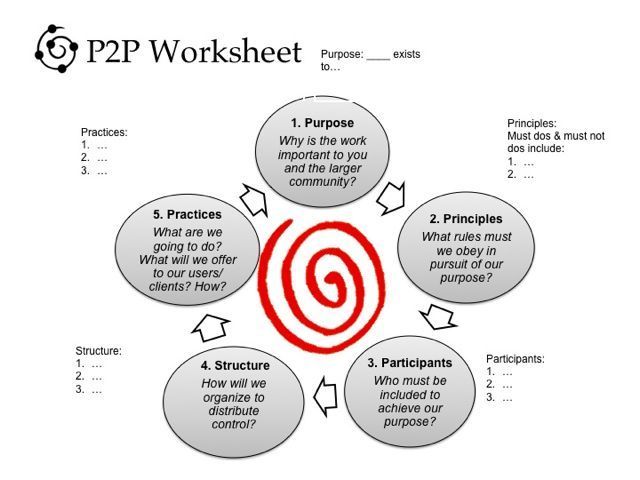
Five Structural Elements – Min Specs
1. Structuring Invitation
- Invite all or most stakeholders to participate in the design of their new initiative in order to specify its five essential elements: purpose, principles, participants, structure, and practices.
2. How Space Is Arranged and Materials Needed
- Chairs and small tables for people to work in groups of 4
- A large wall with poster paper for recording the P2P result for each element
- For each participant five worksheets, one for each of the five elements
3. How Participation Is Distributed
- All individuals who have a stake in launching the initiative are included
- Everyone has an equal opportunity to contribute
4. How Groups Are Configured
- 1-2-4-All
- Whole group for finalizing each element
5. Sequence of Steps and Time Allocation
- Introduce the idea of P2P, the five elements, and related questions, and hand out blank worksheets. 5 min.
- To clarify the first element, Purpose, ask the question: “Why is the work important to you and the larger community?”
- Use 1-2-4 to generate individual ideas and stories for Purpose. 10 min.
- In groups of four, compare, sift, and amplify the top ideas. 10 min.
- As a whole group, integrate themes and finalize ideas for Purpose. 10 min.
- Move to the remaining P2P elements, in turn, repeating the three steps of 1-2-4-All. Be prepared to go back and revise previous elements as needed (expect some messy nonlinearity). Use the following questions to guide the development of the next four elements:
- Principles: “What rules must we absolutely obey to succeed in achieving our purpose?”
- Participants: “Who can contribute to achieving our purpose and must be included?”
- Structure: “How must we organize (both macro- and microstructures) and distribute control to achieve our purpose?”
- Practices: “What are we going to do? What will we offer to our users/clients and how will we do it?”
- After each element, ask, “Has this element shed new light that suggests revisions to previous elements?” 5 min.
- When all elements have been completed, ask participants to step back and take a close look at their draft of the five elements together. Ask them to use What, So What, Now What? in small groups to make sense of all of the possible next steps and prioritize them as a whole group. 15 min.
- After the initiative has been launched, invite the participants to revisit their P2P design periodically and adapt elements based on their experience.
WHY? Purposes
- Engage and focus everyone’s imagination in designing the collective future of participants
- Avoid “design” by a small group of people or experts-only behind closed doors
- Pull together all the elements needed to launch and sustain an effort, thereby avoiding a fragmented process
- Develop innovative strategies that can be implemented and spread quickly because there is shared ownership
- Increase resilience and the ability to absorb disruptions by distributing power fairly
- Build the capacity to rapidly adapt any of the elements to changing circumstances
Tips and Traps
- Crafting a powerful, wildly attractive “purpose” is the most important step: you may want to use Nine Whys, Appreciative Interviews, or TRIZ to deepen the conversation
- A purpose may be expressed as something positive you are going to start/create or something negative you are going to stop
- Work in quick cycles, failing forward iteratively
- Multiple sessions spread out over weeks or even months may be required
- “Structure” usually is the element that requires the most imagination and leaps away from top-down to more distributed control. Using metaphors (e.g., how can we structure ourselves like a spider plant?) and visual representations can help draw out creative designs.
- Principles: Must dos and must not dos often come from hard lessons learned in the field (positive and negative)
- Rely on small groups to do the heavy lifting, and keep it moving
- Keep rounds on schedule and when more time is needed, do two rounds
- Rely on and draw out the inspiring-and-despairing experience of group members
- Invite the participants to use their intuition as the process unfolds
Riffs and Variations
- Start with one 30-minute, very rapid cycle covering all five elements to illustrate the need for a strong and clear purpose: without one, it is easy to come up with a half-baked design
- Graphic recording helps to hold attention and focus through the rigorous design process
- You can add questions to enrich the conversation about Practices: What is happening around us that creates an opportunity? What is at stake if we do not take a risk? Where are we starting, honestly?
- When integrating all five elements for a project is too much, just do the one or two design elements that seem most important
- Use the five P2P questions routinely as an easy checklist for small projects
- Use with virtual groups by inviting participants to answer the five questions via a chat version of 1-2-All. Sift and sort answers with a whiteboard and a person playing a “synthesizer” role. Don’t worry about perfection in the first rounds. Virtual rounds can deepen or complement face-to-face exchanges.
- Use P2P to structure a much longer design session (e.g., a planning or strategy retreat)
- Invite talented participants to take on roles (e.g., writing, drawing, synthesizing)
Examples
- By the leaders of the Conversation Café dialogue movement
- The Quality Commons, a group of researchers from eight health systems, used P2P to successfully create their consortium
- Going through the first stage of the P2P, a management team discovered a much deeper purpose than it expected. The new purpose and shared experience inspired the team to rethink its business model.
- To guide the launch of LS user groups
- By the Latin American region of a corporation to launch a new customer-focused business strategy
Attribution: Liberating Structure developed by Henri Lipmanowicz and Keith McCandless. Inspired by Dee Hock (see his book Birth of the Chaordic Age).
Collateral Material
Below: Output for each of the five P2P questions
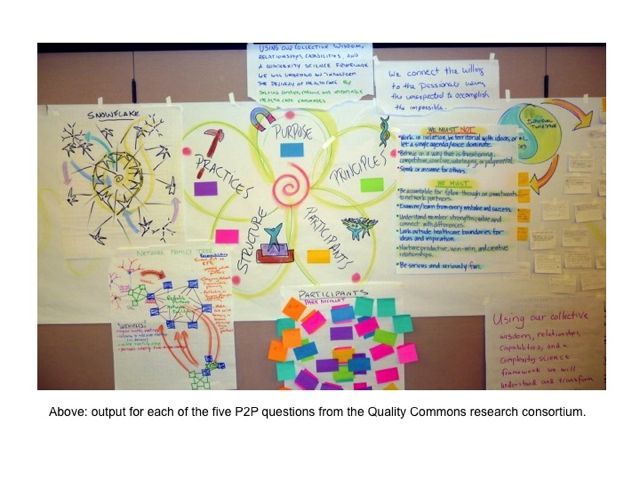
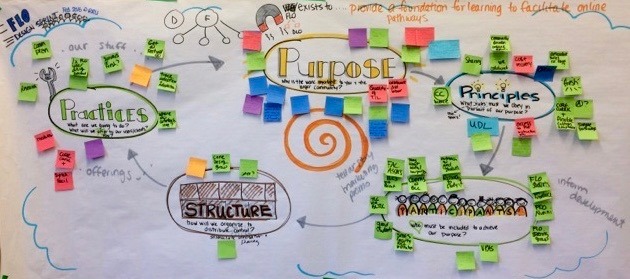 P2P graphic recording by Tracy Kelly
P2P graphic recording by Tracy Kelly
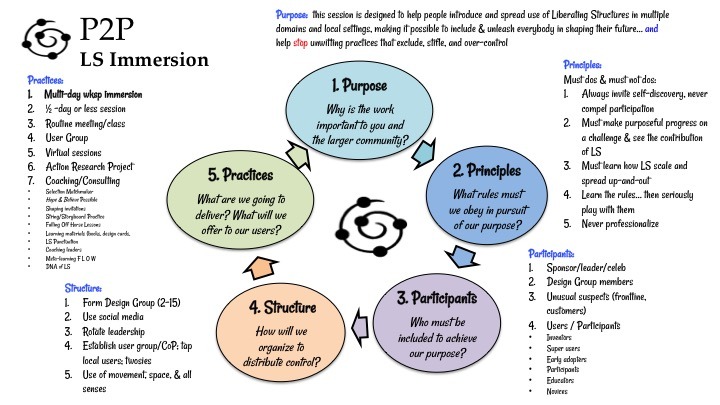 Keith’s P2P for designing LS immersions of all stripes.
Keith’s P2P for designing LS immersions of all stripes.
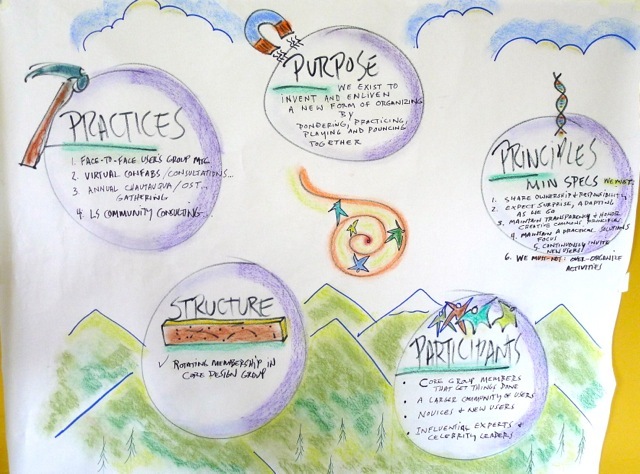 Seattle LS user group P2P design (completed in a 90-minute meeting with 22 participants.) This work has guided and sustained the group for 3 years.
Seattle LS user group P2P design (completed in a 90-minute meeting with 22 participants.) This work has guided and sustained the group for 3 years.
Purpose
Why this work is important to you and the larger community
We exist to invent and enliven a new form of organizing by pondering, practicing, playing, and pouncing together
Principles
The must do and must not do rules we must obey to achieve our purpose
- Users must share ownership of and responsibility for the group
- Users must expect surprise, adapting to opportunities and discoveries as they emerge
- Users must maintain transparency and honor Creative Commons principles
- Users must maintain a practical “solutions focus” to group activities
- Users must not over-organize activities
- Users must continuously invite and welcome new users and novices into the group
Participants
Who must be included to achieve our purpose
- Core group members (those to take responsibility for organizing activities)
- A larger community of LS users (local, regional, national, international users that participate in activities)
- Novices and new users (people invited to join activities by LS users)
- Influential experts and celebrity leaders not actively using LS
Structure
How will we organize (both macro- and microstructures) and distribute control in pursuit of purpose?
For now, Fisher and Keith will coordinate administrative activities (e.g., MeetUp and MailChimp to announce gatherings). Leadership of meetings will rotate among user group members.
Practice
What are we going to do? What will we offer to our users/clients and how will we do it?
Four practices are afloat:
- A monthly face-to-face evening together in Seattle featuring use of LS to advance learning;
- Occasional virtual confabs that include international users and special projects;
- An annual Chautauqua/Open Space shindig;
- And, a LS twist on the Community Consulting model... to help new users get direct experience with complex challenges (low or no cost services are provided to organizations via an experienced LS consultant and a team of less-experienced people that want to learn)
